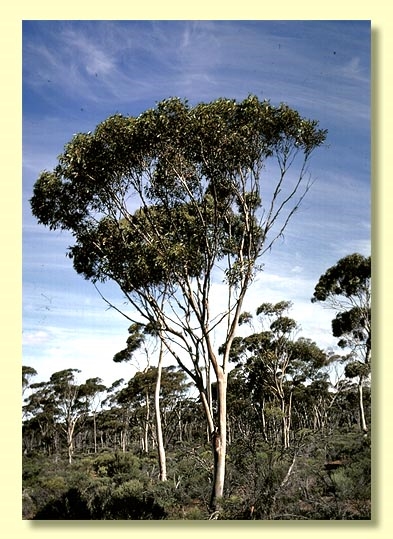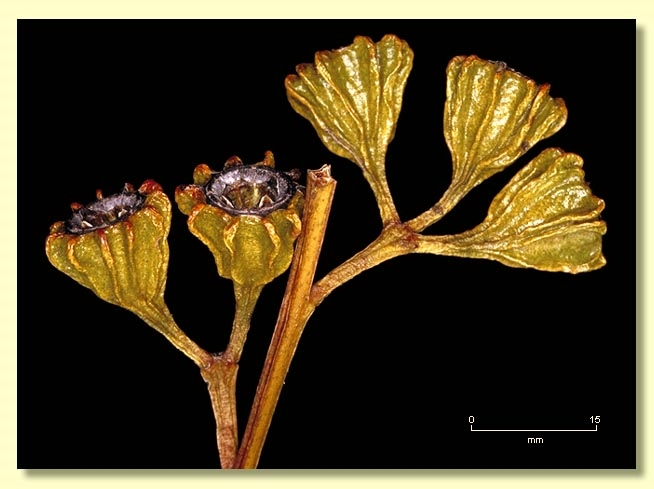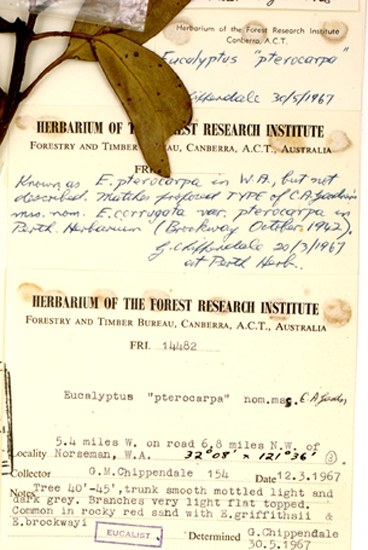Eucalyptus | Symphyomyrtus | Dumaria | Rufispermae
Euclid - Online edition
Eucalyptus pterocarpa
Bark smooth throughout, pale and mid-grey to mottled brown and pinkish white, shedding in long ribbons.
Branchlets have oil glands in the pith. Ultimate branchlets square.
Juvenile growth (coppice or field seedlings to 50 cm): stems square in cross-section; juvenile leaves always petiolate, opposite for ca 5 nodes then alternate, ovate to lanceolate, 6–10 cm long, 2.5–4 cm wide, early leaves slightly glaucous, soon weathering green.
Adult leaves thick, alternate, petioles 1.5–3.3 cm long; blade lanceolate, 8–13.5 cm long, 1.5–2.5 cm wide, base tapering to petiole, margin entire, apex pointed, concolorous, very glossy, mid-green, side-veins at an acute or wider angle to midrib, reticulation dense to very dense, intramarginal vein remote from margin, oil glands mostly intersectional.
Inflorescence axillary unbranched, peduncles broaden apically, 0.7–1.7 cm long, buds (3)7, pedicellate, pedicels 0.6–0.8 cm long. Mature buds broadly fusiform to ovoid (2–2.5 cm long, 1–1.3 cm wide), deeply longitudinally ribbed on both operculum and hypanthium, (the ca 12 ribs or flanges to 3 mm wide), scar present, operculum strongly beaked (1.3–1.6 cm long), stamens inflexed, cuboid to wedge shaped versatile anthers, dorsifixed, dehiscing by longitudinal slits, style long and straight, stigma tapering to rounded, locules 3 or 4, the placentae each with 4 vertical rows of ovules. Flowers white.
Fruit pedicellate, pedicels 0.5–0.8 cm long, usually obconical, sometimes cupular, always with prominent ribs, 1.2–1.5 cm long, 1.4–2.3 cm wide (incl. ribs), disc descending obliquely or rarely level, valves 3 or 4, near rim level or slightly exserted.
Seeds reddish brown and glossy, 1.8–3 mm long, flattened-ovoid and more or less angular, dorsal surface lacunose or not, scarcely reticulate, hilum ventral.
Cultivated seedlings (measured at node 10): cotyledons reniform; stems square in cross-section; leaves always petiolate, opposite for ca 5 nodes then alternate, ovate, 6–8.5 cm long, 3–4.5 cm wide, dull to ca node 8 then becoming glossy, green.
Flowering has been recorded in October.
E. pterocarpa has been cultivated widely as an ornamental.
A small to medium-sized tree (mallet) endemic to Western Australia, known from a couple of localities north-west of Norseman. The bark is smooth and the crown glossy and bright green.
In the classification of Brooker (2000) Eucalyptus pterocarpa belongs in Eucalyptus subgenus Symphyomyrtus section Dumaria having these features: buds initially with two opercula the outer shed early, stamens strongly inflexed, ovules in 4 rows on the placentae and cotyledons reniform. Within section Dumaria the species belongs to a large sub-group of closely related species (series Rufispermae, 37 described species and subspecies) diagnosed by glandular pith in the branchlets, cuboid to wedge shaped versatile anthers, and by the lustrous, reddish brown and glossy, seeds which are unique to the series.
E. pterocarpa, with its largish ribbed buds and fruits, strongly beaked operculum, glossy green crown and smooth trunk, should not be confused with any other species within its range although the fruits alone resemble those of the closely related species E. lesouefii. This species is, however, a blackbutt tree with glaucous seedlings, buds and fruits. Another more distantly related species with prominently ribbed buds and fruit, E. corrugata, is also a blackbutt tree and has distinctive grey-black pitted seeds and flat-topped buds.
Plants similar to E. pterocarpa collected from the general area of McDermid Rock have recently been described as E. frenchiana, a smooth-barked mallet species with ribbed buds but with rounded opercula. It too belongs in series Rufispermae.
















